The past 2 imaging nights I've had issues with guiding. I've noticed the guiding graph has been unusually whacky and it's causing blur and/or double stars.
I always aim to get my total polar alignment error near 30" and normally, my guiding graph reflects makes <1" corrections.
I've been shooting 2-3 min subs and its enough to distort those.
It usually comes in waves. ~60% of my frames are fine and the rest the guiding goes nuts.
But this is still highly unusual since normally +90% are fine on a clear night and I've not had this issue prior (with the same exact imaging train).
I'm trying to narrow down the issues.
I don't think it's wind. These were not windy nights and I'm using an 80 mm refractor.
I also don't think it's a balance issue. If I was off the first night, it wasn't by much. Getting a little closer to perfect balance on the second night didn't help.
I've also reset the guiding calibration in the ASIAIR plus software and and let it re-calibrate guiding. That also didn't fix the issue.
The only thing I can think that's left is my neighbor's motion detector security light which was unusually active for a portion of those nights. But my target was near the zenith, so I can't imagine it would have that big an impact?
Maybe also a cable issue for some of the thinner cables?
> My setup for context:
- 80mm f/6 refractor
- 40mm f/4 guide scope
- ZWO ASI2600MC main camera
- ZWO ASI120MM guide camera
- Dew heaters - both cameras
- EQ6-R mount
- ASIAIR Plus
- SVBONY CLS 2" filter
- Main camera 120-180s subs
- Guide camera 3s subs
|
You cannot like this item. Reason: "ANONYMOUS".
You cannot remove your like from this item.
Editing a post is only allowed within 24 hours after creating it.
You cannot Like this post because the topic is closed.
Copy the URL below to share a direct link to this post.
This post cannot be edited using the classic forums editor.
To edit this post, please enable the "New forums experience" in your settings.
It sounds silly and simple but is the focal length set at 120mm?
I would also shoot 1s and see if that helps.
|
You cannot like this item. Reason: "ANONYMOUS".
You cannot remove your like from this item.
Editing a post is only allowed within 24 hours after creating it.
You cannot Like this post because the topic is closed.
Copy the URL below to share a direct link to this post.
This post cannot be edited using the classic forums editor.
To edit this post, please enable the "New forums experience" in your settings.
Dan Kearl:
It sounds silly and simple but is the focal length set at 120mm?
I would also shoot 1s and see if that helps. Yup, the focal length is correct. That hasn't changed from other nights where it's worked fine, so I don't think that's the issue. For the 1s, I assume you mean the guide scope sub-exposure? I usually run 3s, but I can try that with 1s subs and see if that works.
|
You cannot like this item. Reason: "ANONYMOUS".
You cannot remove your like from this item.
Editing a post is only allowed within 24 hours after creating it.
You cannot Like this post because the topic is closed.
Copy the URL below to share a direct link to this post.
This post cannot be edited using the classic forums editor.
To edit this post, please enable the "New forums experience" in your settings.
Derek Vasselin:
Dan Kearl:
It sounds silly and simple but is the focal length set at 120mm?
I would also shoot 1s and see if that helps.
Yup, the focal length is correct. That hasn't changed from other nights where it's worked fine, so I don't think that's the issue.
For the 1s, I assume you mean the guide scope sub-exposure? I usually run 3s, but I can try that with 1s subs and see if that works. Just check though, I have had a asiair do some funny things and change focal lengths. I use 2s with my EQR-6, but just 1s with my AM5.
|
You cannot like this item. Reason: "ANONYMOUS".
You cannot remove your like from this item.
Editing a post is only allowed within 24 hours after creating it.
You cannot Like this post because the topic is closed.
Copy the URL below to share a direct link to this post.
This post cannot be edited using the classic forums editor.
To edit this post, please enable the "New forums experience" in your settings.
The recent software push has been causing some guidance issues from what I have seen in other posts. Noticed today that ZWO updated the software to fix the issues. Might want to download and see if you are still having issues. - Jim
|
You cannot like this item. Reason: "ANONYMOUS".
You cannot remove your like from this item.
Editing a post is only allowed within 24 hours after creating it.
You cannot Like this post because the topic is closed.
Copy the URL below to share a direct link to this post.
This post cannot be edited using the classic forums editor.
To edit this post, please enable the "New forums experience" in your settings.
Let's start at the beginning so we can make your equipmet work perfectly. Please send some photos of the focal length that you have introduced in Asi air, both the main camera and the guiding one. Your data doesn't add up. If you have an 80mm f/6, the focal length is 480 mm. If you enter a lower value, the RMS that air shows is not correct. 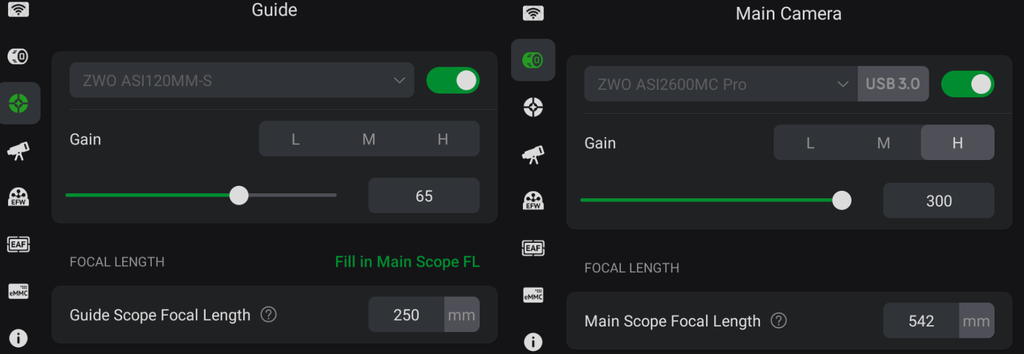 |
You cannot like this item. Reason: "ANONYMOUS".
You cannot remove your like from this item.
Editing a post is only allowed within 24 hours after creating it.
You cannot Like this post because the topic is closed.
Copy the URL below to share a direct link to this post.
This post cannot be edited using the classic forums editor.
To edit this post, please enable the "New forums experience" in your settings.
Send the guiding configuration, in guiding advanced settings. 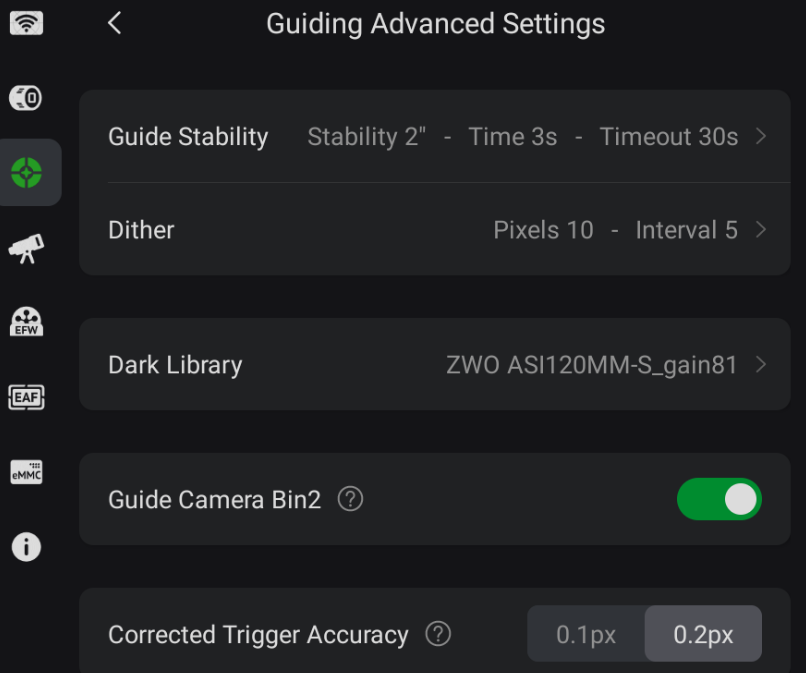 |
You cannot like this item. Reason: "ANONYMOUS".
You cannot remove your like from this item.
Editing a post is only allowed within 24 hours after creating it.
You cannot Like this post because the topic is closed.
Copy the URL below to share a direct link to this post.
This post cannot be edited using the classic forums editor.
To edit this post, please enable the "New forums experience" in your settings.
Excuse me, if my intervention is not really inherent or on the contrary may have similarities with what has been said so far.
A few days ago I upgraded the asiair plus. I must say that as far as driving is concerned it seems to me to have improved overall. But I keep observing during a shooting session (using the PLAN function) that often despite the guidance having error values of less than 1" all of a sudden the error rises by hundreds of seconds of arc. This forces me to interrupt and redo the calibration of the guide.
Does anyone else have any thoughts and advice on this?
Thank you very much,
Lorenzo
|
You cannot like this item. Reason: "ANONYMOUS".
You cannot remove your like from this item.
Editing a post is only allowed within 24 hours after creating it.
You cannot Like this post because the topic is closed.
Copy the URL below to share a direct link to this post.
This post cannot be edited using the classic forums editor.
To edit this post, please enable the "New forums experience" in your settings.
if there is ever a choice to upgrade software/drivers i don't. unless there is a very very good reason.
not a pop at zwo - just in general. let others feel the pain and upgrade at later date unless you absolutely have to.
is there a way to downgrade back to how it was before?
|
You cannot like this item. Reason: "ANONYMOUS".
You cannot remove your like from this item.
Editing a post is only allowed within 24 hours after creating it.
You cannot Like this post because the topic is closed.
Copy the URL below to share a direct link to this post.
This post cannot be edited using the classic forums editor.
To edit this post, please enable the "New forums experience" in your settings.
If I am not mistaken, the possibility of reverting to the previous firmware version is there. But overall I find the firmware improved and also the effectiveness of the guidance algorithms. In fact, the problem that suddenly from a discrete tracking error suddenly showed abnormal values already existed. Now this problem seems to persist, but the feeling is that the ability to keep in small.error (as long as it works) is absolutely more accurate. I was curious if any of you had encountered this behaviour and if you had found a workaround or workaraound. ThanksLorenzo
|
You cannot like this item. Reason: "ANONYMOUS".
You cannot remove your like from this item.
Editing a post is only allowed within 24 hours after creating it.
You cannot Like this post because the topic is closed.
Copy the URL below to share a direct link to this post.
This post cannot be edited using the classic forums editor.
To edit this post, please enable the "New forums experience" in your settings.
@Leonardo Ruiz here are the screenshots. The focal lengths haven't changed from before (when there were no issues), so there shouldn't be any issues there. Please don't take my listed RMS as gospel (I think those were the numbers but I don't have the exact # in front of me). The only thing I've changed from these screenshots is the calibration step. I've played with it around 1500-2500 to troubleshoot but didn't notice any major difference. 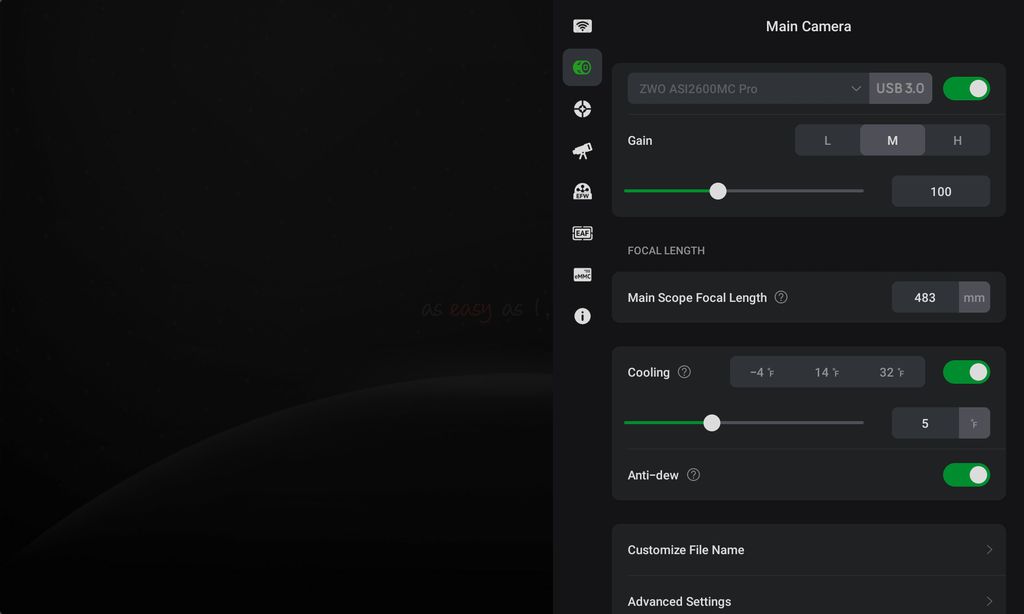 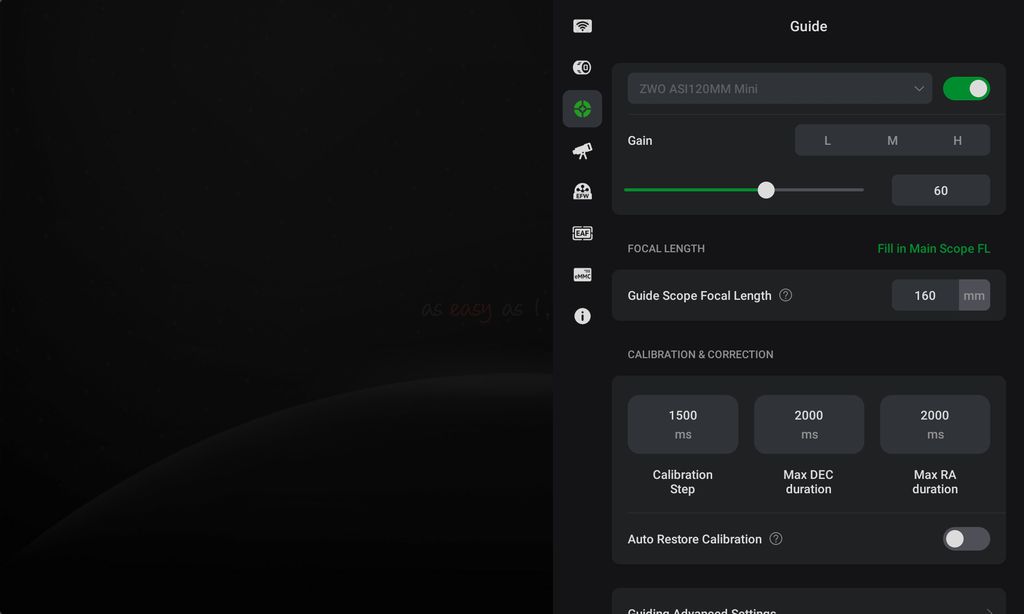 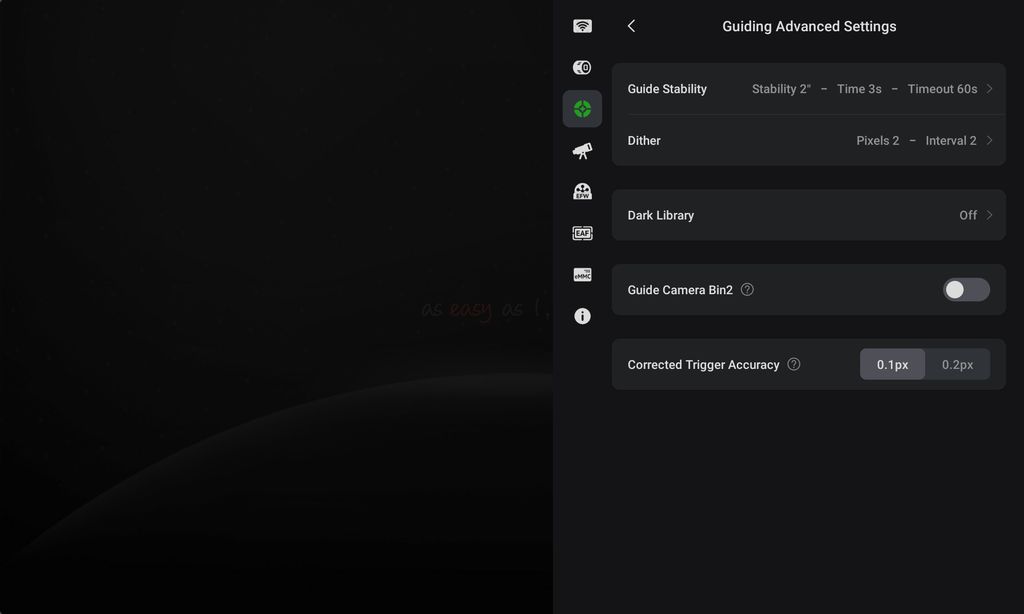 |
You cannot like this item. Reason: "ANONYMOUS".
You cannot remove your like from this item.
Editing a post is only allowed within 24 hours after creating it.
You cannot Like this post because the topic is closed.
Copy the URL below to share a direct link to this post.
This post cannot be edited using the classic forums editor.
To edit this post, please enable the "New forums experience" in your settings.
Why is your guide scope focal length at 160mm and not 120mm?
|
You cannot like this item. Reason: "ANONYMOUS".
You cannot remove your like from this item.
Editing a post is only allowed within 24 hours after creating it.
You cannot Like this post because the topic is closed.
Copy the URL below to share a direct link to this post.
This post cannot be edited using the classic forums editor.
To edit this post, please enable the "New forums experience" in your settings.
Dan Kearl:
Why is your guide scope focal length at 160mm and not 120mm? That's the focal length  |
You cannot like this item. Reason: "ANONYMOUS".
You cannot remove your like from this item.
Editing a post is only allowed within 24 hours after creating it.
You cannot Like this post because the topic is closed.
Copy the URL below to share a direct link to this post.
This post cannot be edited using the classic forums editor.
To edit this post, please enable the "New forums experience" in your settings.
The focal length of the asii120mm mini is 120mm.
I use the 120 , the 220 and the 290 and set the focal for each at 120, 220, 290.
my guiding with the AM5 and the EQ6 is .2-.4 all the time.
|
You cannot like this item. Reason: "ANONYMOUS".
You cannot remove your like from this item.
Editing a post is only allowed within 24 hours after creating it.
You cannot Like this post because the topic is closed.
Copy the URL below to share a direct link to this post.
This post cannot be edited using the classic forums editor.
To edit this post, please enable the "New forums experience" in your settings.
Dan Kearl:
The focal length of the asii120mm mini is 120mm.
I use the 120 , the 220 and the 290 and set the focal for each at 120, 220, 290.
my guiding with the AM5 and the EQ6 is .2-.4 all the time. Focal length is determined by the guide telescope, not the guide camera. Doing what you have suggested will cause issues, including too low or too high guide error.
|
You cannot like this item. Reason: "ANONYMOUS".
You cannot remove your like from this item.
Editing a post is only allowed within 24 hours after creating it.
You cannot Like this post because the topic is closed.
Copy the URL below to share a direct link to this post.
This post cannot be edited using the classic forums editor.
To edit this post, please enable the "New forums experience" in your settings.
Jonathan:
Focal length is determined by the guide telescope, not the guide camera. Doing what you have suggested will cause issues, including too low or too high guide error. Mu guiding is exceptional. never have a problem using the focal length of the camera in the asiair setting. Since the OP is having problems, I suggest he try it.
|
You cannot like this item. Reason: "ANONYMOUS".
You cannot remove your like from this item.
Editing a post is only allowed within 24 hours after creating it.
You cannot Like this post because the topic is closed.
Copy the URL below to share a direct link to this post.
This post cannot be edited using the classic forums editor.
To edit this post, please enable the "New forums experience" in your settings.
Dan Kearl:
Jonathan:
Focal length is determined by the guide telescope, not the guide camera. Doing what you have suggested will cause issues, including too low or too high guide error.
Mu guiding is exceptional. never have a problem using the focal length of the camera in the asiair setting. The camera doesn't have a "focal length". The 120 is the part number, and the mm refers to it being a monochrome camera. Same goes for the 220mm, 290mm, etc. Your guiding may report as being excellent, but with an incorrect focal length it probably doesn't reflect your true guiding error. If your guide scope focal length is close to what you entered (for example, using one of the small 120mm guide scopes with the asi120mm), you likely wouldn't notice in the final images, but a large discrepancy absolutely has the potential to show up in your image, even if your error reports as excellent.
|
You cannot like this item. Reason: "ANONYMOUS".
You cannot remove your like from this item.
Editing a post is only allowed within 24 hours after creating it.
You cannot Like this post because the topic is closed.
Copy the URL below to share a direct link to this post.
This post cannot be edited using the classic forums editor.
To edit this post, please enable the "New forums experience" in your settings.
Jonathan:
Your guiding may report as being excellent, but with an incorrect focal length it probably doesn't reflect your true guiding error. If your guide scope focal length is close to what you entered (for example, using one of the small 120mm guide scopes with the asi120mm), you likely wouldn't notice in the final images, but a large discrepancy absolutely has the potential to show up in your image, even if your error reports as excellent. Thank you very much for the info, apparently I have been doing it wrong for 2 years but routinely get excellent guiding results for 10 min subs using the camera focal length designation. You can look at my portfolio, my stars are excellent generally, I have no problem guiding.
|
You cannot like this item. Reason: "ANONYMOUS".
You cannot remove your like from this item.
Editing a post is only allowed within 24 hours after creating it.
You cannot Like this post because the topic is closed.
Copy the URL below to share a direct link to this post.
This post cannot be edited using the classic forums editor.
To edit this post, please enable the "New forums experience" in your settings.
Dan Kearl:
Jonathan:
Your guiding may report as being excellent, but with an incorrect focal length it probably doesn't reflect your true guiding error. If your guide scope focal length is close to what you entered (for example, using one of the small 120mm guide scopes with the asi120mm), you likely wouldn't notice in the final images, but a large discrepancy absolutely has the potential to show up in your image, even if your error reports as excellent.
Thank you very much for the info, apparently I have been doing it wrong for 2 years but routinely get excellent guiding results for 10 min subs using the camera focal length designation. You can look at my portfolio, my stars are excellent generally, I have no problem guiding. Jonathan, you are not doing anything wrong, you just have a confusion of concepts. I see that you have 2 guide tubes, an SVBony SV106 50mm Guide Scope with a 190 mm focal length and a William Optics UniGuide 50 with a 200 mm focal length. As Dan very well says, cameras do not have a focal length but rather the objectives and telescopes and that is the data that is entered in asi air, the focal length of the optics that we use in the main camera and the focal length of the guide tube that goes in the guidance chamber. So air reduces it to Focal Main camera or Focal guide Cam, perhaps that's why the confusion. In your case, by telling Asi Air that you have a 120mm focal length when it is actually using a 200mm focal length, you cause a false RMS value. You say that your guidance is always 0.2 to 0.4 "/pixel, which corresponds to values of much more precise mounts. Change the focal length in asi air, from 120 to 200mm or 190 mm and you will obtain the real RMS value with which you are guiding. You will guide with exactly the same precision as you have now, but the RMS data will be real and that will help you know your equipment better.
|
You cannot like this item. Reason: "ANONYMOUS".
You cannot remove your like from this item.
Editing a post is only allowed within 24 hours after creating it.
You cannot Like this post because the topic is closed.
Copy the URL below to share a direct link to this post.
This post cannot be edited using the classic forums editor.
To edit this post, please enable the "New forums experience" in your settings.
Leonardo Ruiz:
Jonathan, you are not doing anything wrong Please check who said what in the conversation, you are responding to the wrong person which could cause additional confusion.
|
You cannot like this item. Reason: "ANONYMOUS".
You cannot remove your like from this item.
Editing a post is only allowed within 24 hours after creating it.
You cannot Like this post because the topic is closed.
Copy the URL below to share a direct link to this post.
This post cannot be edited using the classic forums editor.
To edit this post, please enable the "New forums experience" in your settings.
Leonardo Ruiz:
Dan Kearl:
Jonathan:
Your guiding may report as being excellent, but with an incorrect focal length it probably doesn't reflect your true guiding error. If your guide scope focal length is close to what you entered (for example, using one of the small 120mm guide scopes with the asi120mm), you likely wouldn't notice in the final images, but a large discrepancy absolutely has the potential to show up in your image, even if your error reports as excellent.
Thank you very much for the info, apparently I have been doing it wrong for 2 years but routinely get excellent guiding results for 10 min subs using the camera focal length designation. You can look at my portfolio, my stars are excellent generally, I have no problem guiding.
Jonathan, you are not doing anything wrong, you just have a confusion of concepts. I see that you have 2 guide tubes, an SVBony SV106 50mm Guide Scope with a 190 mm focal length and a William Optics UniGuide 50 with a 200 mm focal length. As Dan very well says, cameras do not have a focal length but rather the objectives and telescopes and that is the data that is entered in asi air, the focal length of the optics that we use in the main camera and the focal length of the guide tube that goes in the guidance chamber. So air reduces it to Focal Main camera or Focal guide Cam, perhaps that's why the confusion.
In your case, by telling Asi Air that you have a 120mm focal length when it is actually using a 200mm focal length, you cause a false RMS value. You say that your guidance is always 0.2 to 0.4 "/pixel, which corresponds to values of much more precise mounts. Change the focal length in asi air, from 120 to 200mm or 190 mm and you will obtain the real RMS value with which you are guiding. You will guide with exactly the same precision as you have now, but the RMS data will be real and that will help you know your equipment better. I think you are confusing what Jonathan says vs, what I said. I am confused as I use the number of the guide camera for the guide scope focal length and it works very well. Here is an image I took last night using my askar 103 scope with a 533mc (effective focal length of 1900+-) I used the asi290mm mini with a Williams 50mm guide scope. I use 290mm as the guide focal length. This is 17-600 sec. subs. I don't understand how the stars can be this good if my asiair values are so wrong? 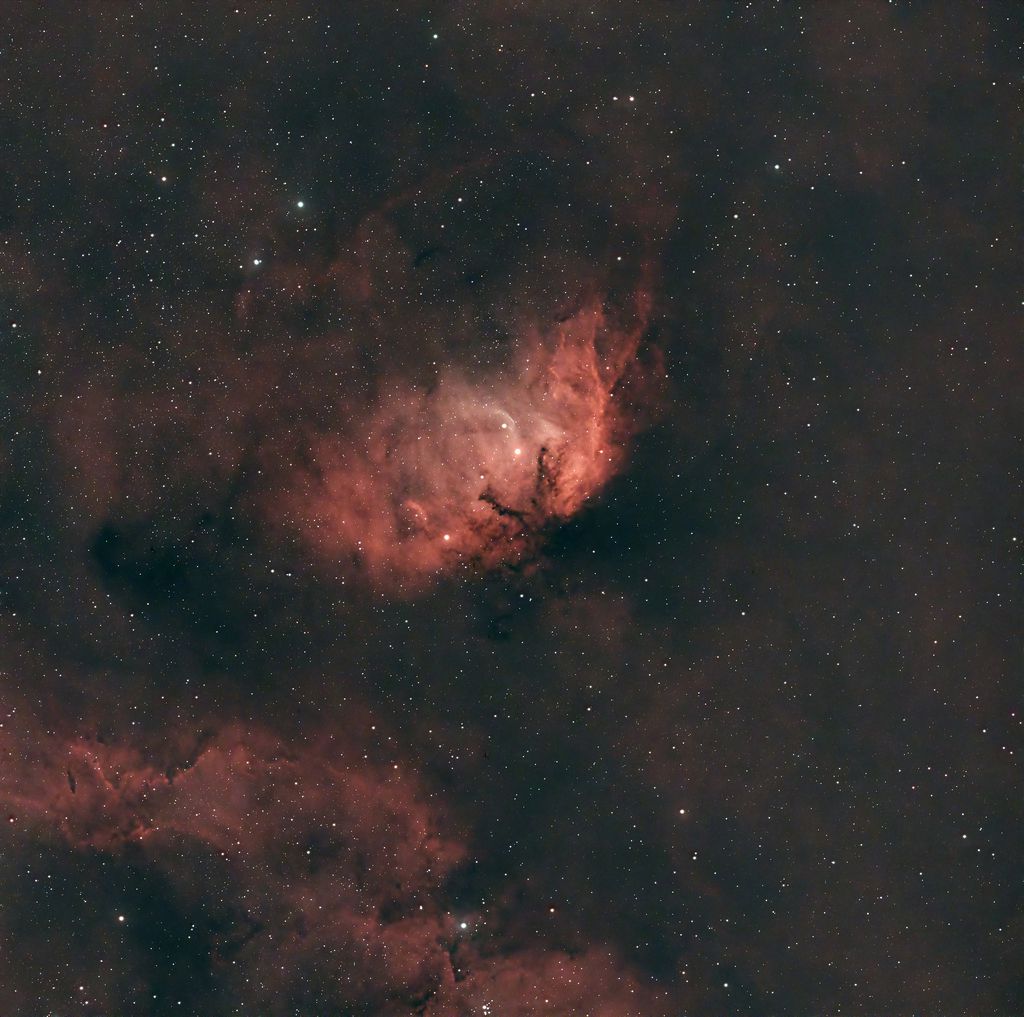 |
You cannot like this item. Reason: "ANONYMOUS".
You cannot remove your like from this item.
Editing a post is only allowed within 24 hours after creating it.
You cannot Like this post because the topic is closed.
Copy the URL below to share a direct link to this post.
This post cannot be edited using the classic forums editor.
To edit this post, please enable the "New forums experience" in your settings.
Dan Kearl:
I don't understand how the stars can be this good if my asiair values are so wrong? If your true guiding error is still reasonable, you will still get good stars, it's just that your reported error won't be accurate. I'm sure one could do the math if they were so inclined, but just as a rough estimate if your reported error was 0.2-0.4 at "290mm" but you were actually at 200mm, it's still likely that your true error was less than 1 and probably still good enough for your 533mc with the askar103 (pixel scale of about 1.1)
|
You cannot like this item. Reason: "ANONYMOUS".
You cannot remove your like from this item.
Editing a post is only allowed within 24 hours after creating it.
You cannot Like this post because the topic is closed.
Copy the URL below to share a direct link to this post.
This post cannot be edited using the classic forums editor.
To edit this post, please enable the "New forums experience" in your settings.
Jonathan:
Leonardo Ruiz:
Jonathan, you are not doing anything wrong
Please check who said what in the conversation, you are responding to the wrong person which could cause additional confusion. Sorry Jonathan, you're right, I changed your names, sorry.
|
You cannot like this item. Reason: "ANONYMOUS".
You cannot remove your like from this item.
Editing a post is only allowed within 24 hours after creating it.
You cannot Like this post because the topic is closed.
Copy the URL below to share a direct link to this post.
This post cannot be edited using the classic forums editor.
To edit this post, please enable the "New forums experience" in your settings.
Derek Your focal values are fine, so we will review each parameter to achieve correct guidance. To start, I advise you to activate Dark Library in advanced Guiding settings. Basically it makes some darks and achieves greater contrast in the guidance image, which improves precision. In the same way, it activates Guide cam Bin2, thereby making larger pixels that are better detected. They are not essential parameters but they can help. When you have a good guide, activate and deactivate to see what works best for you. You mentioned that in polar alignment you got values less than 30", that is perfect. However, I advise you to focus as best as you can so that Asi air can read with greater precision. I use an EAF for greater precision. Another thing is the time of exposure in Polar alignment, if it is too low it will not detect the stars well, if it is excessive it will saturate them and you will not be able to distinguish the centroid of the pixel. I use 3" seconds for LRGB and 10" for Narrow band. Once we achieved a good alignment and had made a good parking position, we began to evaluate the guidance.=Y2IQFcIn your case, with a 483 mm focal length and 3.76 μm pixel size, you should achieve an RMS less than 1.61"/pixel. I copied the link so you can see the calculations. https://astronomy.tools/calculators/ccd_suitabilityThe resolution value is the maximum RMS value that you should achieve. Let's keep going. First make sure you have trackin activated on your mount. Before starting the guidance, let's make sure of several things: Focus the guide tube. The stars must be as punctual as possible. Dec mode: shows the North/South deviation, leave it on automatic. Calibrate the guidance. Very important, every time we make the meridian jump, we must recalibrate. Start with the guidance. First we see two graphs corresponding to Declination (Red) and AR (blue). The declination shows us the deviation from the north. The AR shows the error in the balance. Start with an exposure time of 1 second. In Guide set the Max DEC and RA duration values to 2000ms. In Mount, set the guidance speed to 0.9x. In aggressiveness it starts with 60% in DEC and AR. Start guiding Gradually increase the aggressiveness and evaluate whether the error increases or decreases. If increasing improves, you can increase the values of Max DEC or RA duration from 2000ms to 9000ms Do your tests and if you want, tell us. Good luck
|
You cannot like this item. Reason: "ANONYMOUS".
You cannot remove your like from this item.
Editing a post is only allowed within 24 hours after creating it.
You cannot Like this post because the topic is closed.
Copy the URL below to share a direct link to this post.
This post cannot be edited using the classic forums editor.
To edit this post, please enable the "New forums experience" in your settings.
I am also having trouble guiding with the ASIAIR PLUS, ASI120mm mini, and the 120mm guide scope. I am using it on the SkyWatcher Star-Adventurer GTi. On it I have mounted a Canon mirrorless camera with an arca swiss bracket attached under it for the guiding. My focal length is 560mm and the camera has is a crop sensor. The bracket is firmly fastened on the camera and the RA is balanced very well. The DEC, not that good because of the guidescope on the side 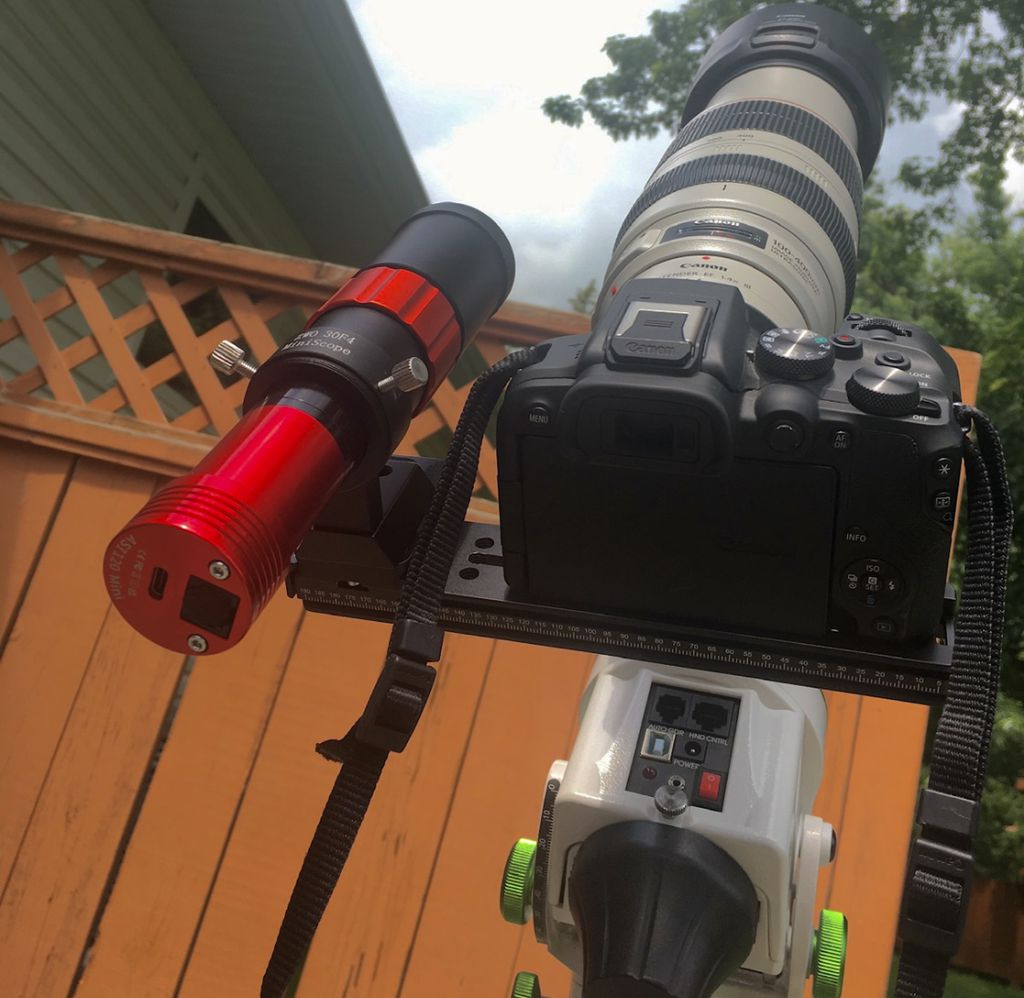 After using the ASIAIR plus for a few months without trouble, I suddenly started having problems with the calibration. It would start from the beginning with the West steps where it would move the wrong way and the distance would reach 25 in 4 steps then when it switches to the east steps, it continues moving in the same direction and the distance increases to like 75. So I restart the calibration until I see that the West steps finish in about 10 steps and then usually the rest of the calibration continues without problems. But I would like to know why these problems are there in the first place. Here are my settings: 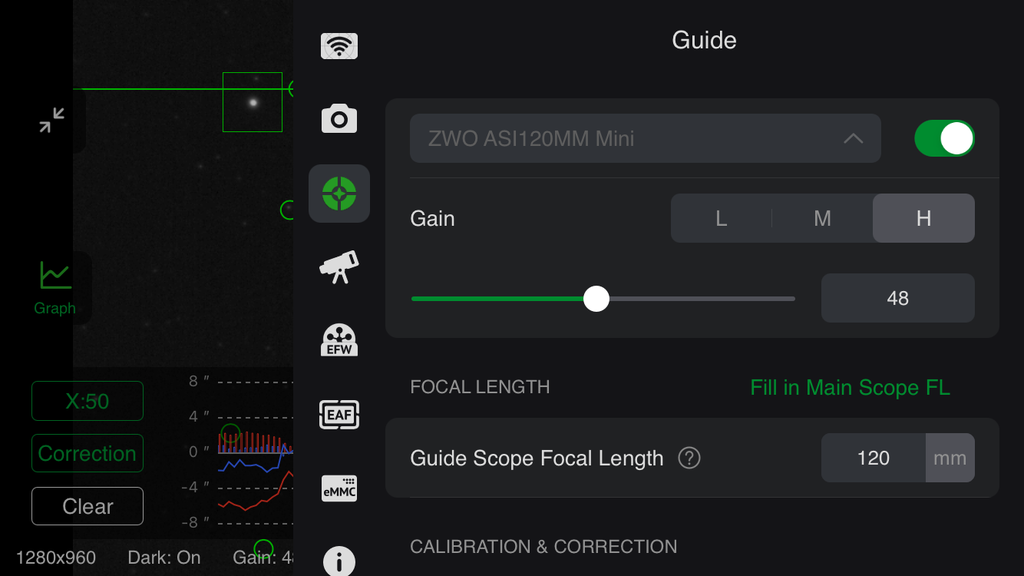 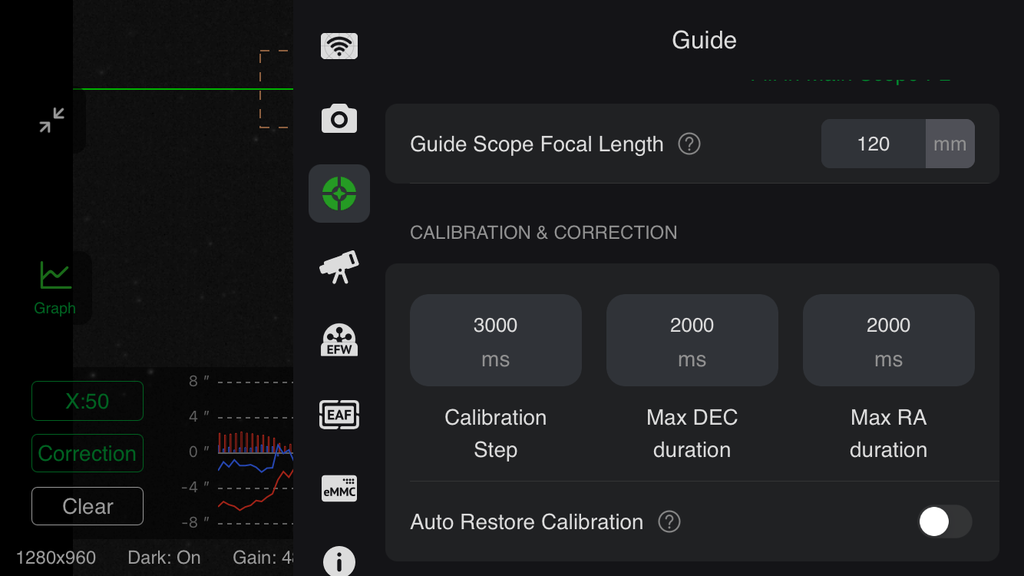 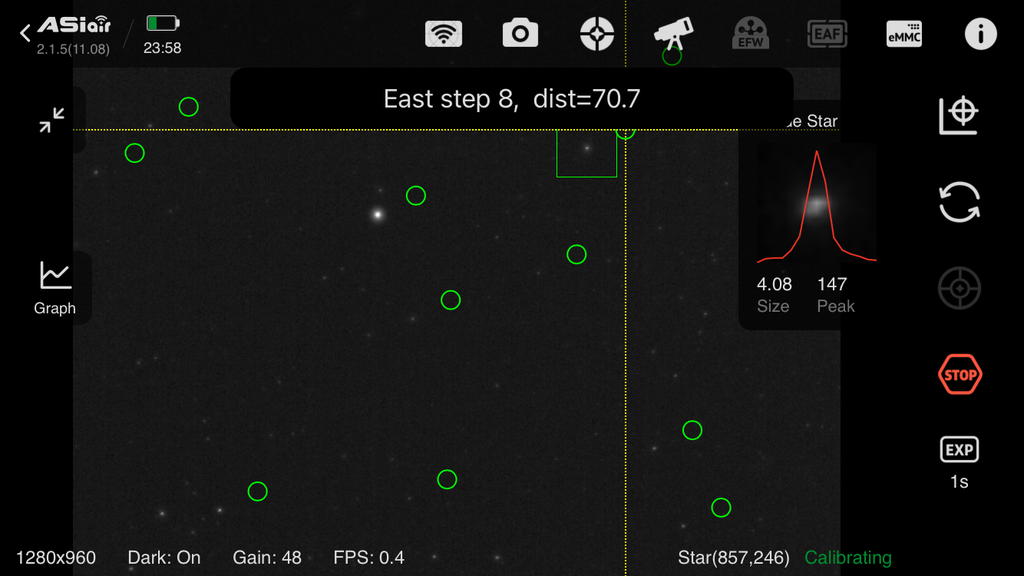 Now the problem with the regular guiding. Sometimes guiding works without problems for the whole night but sometimes it doesn’t work at all. After calibration it starts guiding normally for the first minute or so then RA and DEC numbers rise to like 400“. Sometimes at some point it starts climbing back but never recovers. Last night I was trying to photograph the Western Veil nebula when this happened. After trying to get the guiding running for an hour, I switched targets to M 27 any suddenly everything worked. I recalibrated and guiding worked perfectly, about 0.5“. But then after the meridian flip at like 2 am, it made the same trouble I had with Veil Nebula. I tried over and over again with no luck and I tried again on the Veil with the same results. 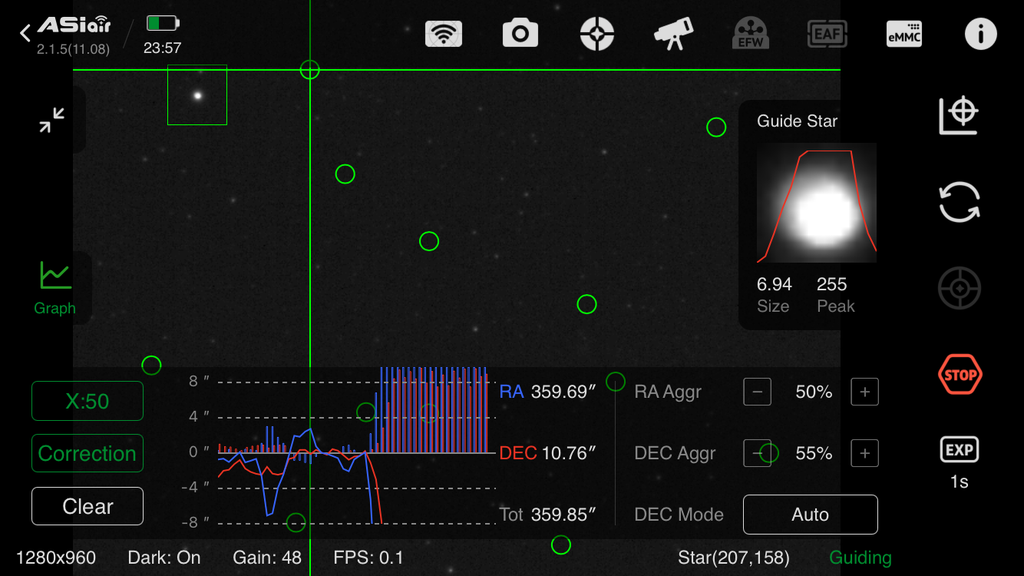 I am wondering if the calibration problems are related with the guiding issues. I noticed that when it is moving in the wrong direction while calibrating, it moves the same direction when the guiding is way off. I thought maybe these issues also might be because the not perfect balance on the Dec axis but when its not guiding properly its the RA not the dec. Sorry if some things don’t make sense but I thought I‘d ask around a little because I am having these issues for the last few weeks, almost daily. Does anybody know what might be causing these issues? Thanks, Henric
|
You cannot like this item. Reason: "ANONYMOUS".
You cannot remove your like from this item.
Editing a post is only allowed within 24 hours after creating it.
You cannot Like this post because the topic is closed.
Copy the URL below to share a direct link to this post.
This post cannot be edited using the classic forums editor.
To edit this post, please enable the "New forums experience" in your settings.














